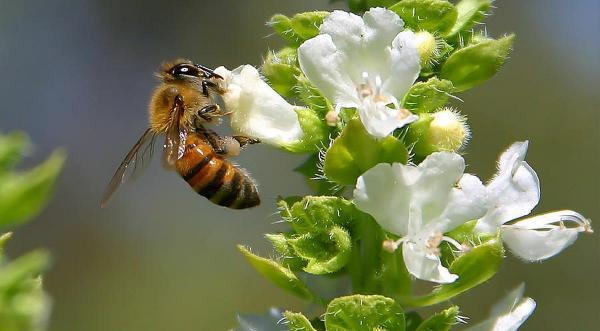Dripping Gardening February 6

When you think of bees, it probably isn’t your first instinct to want to attract more of them to your yard.
These striped insects often get a bad rap due to their rather painful natural defense mechanism and are often shoed away from the garden by harsh insect repellents and pesticides.
Unfortunately, this negative outlook on bees and the rise of industrial farming along with the increased pace of urbanization has caused bees populations to decrease and what some consider an alarming rate. This lowering of bee populations is a concern for many reasons, namely the continued pollination of the fruit and vegetable crops of the worldwide food supply. Or, on a more personal level, my summer tomatoes! Bees play an essential role in pollination, and without them, the world could be facing an agricultural crisis. This situation came to light about ten years ago and we still have not solved the problem, bees are still at risk.
In China for example, Hanyuan county is known as the “world’s pear capital.” But pesticide use has led to a drastic reduction in the area’s bee population, threatening the fruit crop. Workers now pollinate fruit trees artificially, carefully transferring pollen from male flowers to female flowers to fertilize them.
On the one hand it’s a story about the human toll on the environment, while on the other it shows humankinds ability to be more efficient in spite of it all.
Bee populations are declining worldwide, according to a 2018 report from the United Nations. Shrinking numbers of bees could result in the loss of “hundreds of billions of dollars” worth of crops every year. That does not only mean that big companies will lose money, but people around the world could lose access to certain foods.
But in some parts of China, hand pollination can actually cost less than renting bees to pollinate crops. Farmers in Hanyuan began pollinating by hand because human labor was cheap. But rising labor costs and declining fruit yields are calling the long-term viability of hand pollination into question. Bottom line? If we want and need pollinators, we need bees.
So, what can you do?
Creating a welcoming garden for the bees, raising awareness of their importance to the ecosystem, and discontinuing the use of harmful chemicals in your yard are a few simple ways that you can make a difference. The following eight flowers are especially attractive to bees and can make your garden a paradise for these beneficial insects.
Catmint - Along with being incredibly hardy and easy to grow, catmint has beautiful purple flowers during its blooming season and lovely silvery-green foliage the rest of the year. Be sure to contain catmint in a pot or plant it somewhere that you don’t mind it spreading.
Bee balm - As the name would suggest, bees and other pollinators such as butterflies love this vibrant plant. It also provides a wonderful fragrance and an eye-catching pop of color for your garden.
Foxglove - If you are looking for a flower to add a bit of height to the back of your garden, foxglove is a great choice. It does well when planted in moist, shady conditions which means that it will flourish under an overhang against the side of your house or under a tree.
Anise hyssop - Another vertical wonder, anise hyssop produces tall shoots with lots of flowers that allow bees and butterflies to congregate. Deadheading the spent flowers will encourage more blossoms later in the season. Plus, the leaves have a wonderful anise scent when disturbed.
Crocus - Often the tiny crocus blooms are the first hint that spring is on the horizon, not so much here in central Texas, but in many parts of the country they are often found popping up even when there’s still a dusting of snow on the ground. When planted in clusters, these flowers make an appealing target for all types of bees and give your eager flying friends a dose of nectar when other plants haven’t begun to bloom.
Calendula - If you live in an area with cooler temperatures or have an area of your yard with a cooler microclimate, calendula or “pot marigold” as it is sometimes referred to, could be an excellent addition to your garden. Bees love this yellow plant, and since it reseeds, it will be a source of beauty and bee sustenance for years to come.
Lavender - Plant lavender in areas with well-drained soil and full sun. Not only is this fragrant herb an alluring bee attraction, but it can also be used in many ways in the kitchen and aromatherapy. Even better, deer and rabbits tend to leave lavender alone which is essential if you’ve had a problem with these destructive guests in the past.
Basil – I grow load of basil, much of it goes into pesto, pizza, and other food favorites but I always allow about 25% of my basil to go to seed. Pretty flowers, white to pin and purple depending on the variety, are a real favorite of the bees in my neighborhood.
How about some tips for choosing flowers that attract bees?
Of course, this list is far from exhaustive and there is a myriad of other plants that bees love. Here are a few guidelines to keep in mind as you cultivate your bee-friendly garden.
Fragrant blooms - Many of the flowers on the list above are distinctly known for their delightful scent. There is a reason for that! Bees are strongly attracted to the sweet scent of flowers and will frequent your garden more often if it is home to delightful natural perfume.
Bright Flowers - Pigmentation in flower is solely to attract pollinators. Sorry folks but it is true, flowers look lovely, not for us but solely to attract pollinators. Be sure to plant bright flowers in your garden, especially shades of yellow, white, blue, and purple. Plant them in clumps of the same color as it is like putting up a billboard for the bees as they are flying by.
Native plants - Do some research and discover which plants are native to your region or find a local nurseryman and ask him. Planting native flowers draws in local bees and helps encourage them to stay in the area.
Early spring flowers - Coming out of winter, it is essential that bees have a good food supply. Be sure to fill your garden with plants that flower all season, starting as early as possible. Plus, this will allow you to enjoy a colorful garden for longer.
Look around this year and you will notice that the bees are out earlier than normal, that is due mainly to our exceptionally mild winter. But there is a problem, the food sources the bees need are not in full bloom yet. You can help the bees by allowing your lawn to go a little wild – let it get longer before you mow it down.


